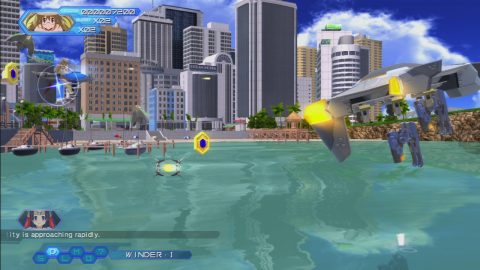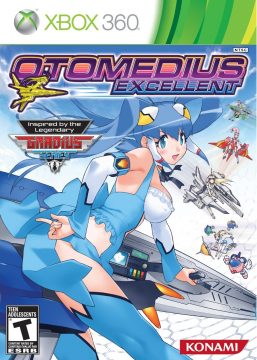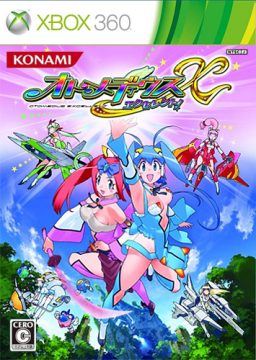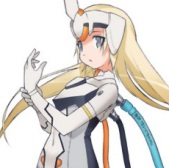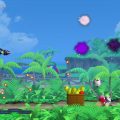Otomedius wasn’t exactly a fan favorite when it came out, but it must’ve done well enough for Konami to justify a sequel. Otomedius X, otherwise known as Otomedius Excellent, was designed specifically for the console audience, removing most of the stuff that was introduced in its predecessor in favor of a more traditional Gradius-style experience. Koji Igarashi, mostly known for his role in the Castlevania series, also took over the role of Producer.
Most of the cast from the original Otomedius, with the exception of Emon 5, who was always the odd man out anyway. There are four new characters (well, three considering one of them is functionally the same as Emon), as well as a new fleet of boss character inspired by other Konami games.
The Good Guys
Arnval
RV: Anthurium
Arnval is from Busou Shinki, a line of figures from Konami that also happens to be about mecha shoujo. Since Emon 5 is the only character missing from this game, she takes up his arsenal.
Straf
RV: Alpinia
Straf is Arnval’s sister, and also from Busou Shinki. The Alphina is the third selectable ship in the Gradius 3D spin-off Solar Assault. Two of her weapons, the Psycom Laser and Mind Blast, are taken from that game. Unfortunately she is only available as DLC.
Gesshi Hanafuuma
RV: Axelay Viper
Gesshi Hanafuuma hails from the Konami Famicom game Getsu Fuuma Den. Her options are replaced by a “Hadouken” power (translated as “Wave Sword”), which is at the first spot on her power-bar to be easily equipped or powered up, and are multi-directional wave attacks. The rest of the weapons and the design of her ship are borrowed from the SNES shooter Axelay, with the exception of her Platonic Burst, which summons a fire dragon a la the ship from Trigon / Lightning Fighters.
Kokoro Belmont
RV: Stavros
Kokoro Belmont is inspired by the Castlevania series. Her primary weapons are the Laser Whip, Holy Water as bombs, and axes and cross boomerangs as other weapons. Her ship, the Stavros, is taken from Trigon / Lightning Fighters, which had also guess starred in the boss rush of Gradius Gaiden. Her Platonic Burst attack is the cross shaped laser, the other super attack from that game, and her option is named the Trigon, which powers up its weapon rather than replicating. Unfortunately she is only available as DLC.
The Bad Guys
Neko Sencho
The cat pirate ship from Parodius Da! (and reappearing a few other times in the series) has been turned into a bikini-clad girl, and commands the Mirrored Core, the first level boss.
T. B. Rika
T.B. Rika is supposed to be a teacher at Gradius High School, but she’s actually a secret Bacterian! Her name suggests she is inspired by Chichibinta Rika, the Vegas dancer from the second level of Parodius Da!, which in turn mimicked the Shadow Dancer crab robot in Gradius II.
Ryukotsuki
Ryukotsuki is a girlie version of the demonic dragon-skeleton boss of Getsu Fuuma Den. She commands a snake-like vessel called the Serpent Core.
Shiori Fujisaki
The poster girl for Konami’s Tokimeki Memorial dating sim returns as the level five boss, albeit in a different school uniform. She commands the Heaven’s Gate, which is a hidden ship from the boss rush in Gradius Gaiden that only appears in the second loop. The artwork gallery indicates that she was initially meant to pilot something called “Force Gear”, which is the name of the Konami shooter minigame hidden in the PC Engine version of Tokimeki Memorial.
Ruby & Cobalt
RV: Stavros
This duo of mechanical bunny girls are essentially roboticized versions of Hikaru and Akane, who initially appeared as playable characters in Gokujou Parodius. They helm the Metal Slave, which is the final boss of the MSX version of Salamander.
Dark Force
When you first face Dark Force, she is far too powerful to be taken down, considering she wipes out a huge chunk of the Gradian fleet with a single missile blast. In what is probably a reference to Gradius V, the only way to beat her is to travel back through time to defeat her when she’s still a child. She pilots the Black Viper, which first made an appearance in Sexy Parodius as the second player version of the Shooting Star. The artwork gallery also shows that part of her ship is inspired by the winged pod from Quarth.
From the moment Otomedius Excellent boots up, it’s evident that Konami had a bit more faith in this project, enough to give it more of a budget. The crappy intro from the first game was given way for a full animated movie, complete with a peppier vocal song. The graphics, while still not exactly high class, are a substantial improvement nonetheless, with subtly cel-shaded player characters and improved background effects. The portraits of both the girls doing their special attacks and the bosses taunting you are now animated, usually with a fair bit of bounce.
There are a total of eight levels, though the final one can only be reached by successfully killing the seventh level boss before it times out. All of the elemental, RPG and scoring systems have been gutted or simplified. Enemies still drop colored gems, but they only slightly increase your score. The Burst system has changed up a bit too. Rather than a meter, you simply have stocks like bombs. The Quick Bursts will hit everything on the screen and consume one stock. However, you can execute a Platonic Break by holding down the button for several seconds, which will unleash a character specific special attack. These are rather handy, seeing as they don’t consume any Burst stocks and the penalty to suffer from using them is a slight cooldown period. Unfortunately, enemies killed with the Bursts no longer drop power-up capsules, nor is there the ability to replenish them with the power bar. Instead, Bursts are only restored upon dying or finding a rare icon, so it’s not conducive to scoring anymore. Characters still level up after completing a game, but for the most part, other than gaining ranks and unlocking Achievements, these don’t actually do much. The only character it affects is Hyper Anoa, an unlockable super version of Anoa which has a massive power bar, who gains new weapons as she ascends through the ranks.
The weapon unlocking system has been completely overhauled, though it’s not without its quirks. Each character now has their power meter arranged differently, with a few having weapons exclusive to them, and there are several alternate weapons already available from the start. New weapons are unlocked by killing certain enemies in specific levels on various difficulty levels and modes. It’s all still a bit abstract, because while you’ll still need to play the game over and over, you don’t have any way to knowing which weapons you’ll get unless you read a FAQ beforehand. Perhaps some kind of shop like Otomedius G would’ve been better, especially since many can only be found in the higher loops of the Score Attack.
Strangely, the easiest way to unlock most of the weapons is through the game’s bizarre co-op mode, which lets you pick the difficulty level, stage and loop, and allows three players to play simultaneously. However, the second and third players can die as much as they want, while only the first player has limited lives. If they run out, then it’s Game Over for everyone. It’s also particularly frustrating since each stage skips the power-up intro area, placing you right in the middle of combat without anything equipped and thereby easy pickings, so obtaining certain weapons is a huge exercise in frustration. Still, in general you’ll unlock them much faster than in the first game, and they are shared amongst all of the characters, so there’s no need to grind each character up to equip them.
While most of these are welcome improvements, the quality of the actual game is a bit more questionable. The stages are faster and better designed than the ones in Otomedius G, but for the most part, they’re still too easy unless you’re playing in Expert mode or playing the higher loops, which are inaccessible in Story mode. Most of the levels have a very “been there, done that” sort of feeling. Mimicking the original Otomedius, the first two levels take place on a seaside resort and by a cityscape. Other areas are reminiscent of other games including a cave filled with sand a la Gradius III, a ship graveyard like Gradius Gaiden, a large fleet battle like Salamander 2 (and countless other shooters), another boss rush, and a typical Gradius-style base level, complete with a speed up zone. The only really original stage takes place in a jungle, where you descend down a waterfall and take out a gigantic Big Core boss by flying right up into it. There are no more penguins, so it no longer feels like a Parodius game.
You no longer crash or take damage by running into floors of ceilings. However, the hit box is still too large, awkward, and hit to discern, though the Practice mode will highlight it. While it does feel more like a classic Gradius game, there’s no way to turn off resurrection and implement checkpoints. Most troublesome, the damage output is incredibly unbalanced. Many of the mid-size or boss enemies simply take way too much damage or have cores that are way too small to hit unless you have specific weapons are equipped. It’s a shame how extraordinarily expansive the arsenal in this game is, yet so many of the weapons are almost useless on many of the characters, simply because they aren’t strong enough to kill bosses before they time out. As a result, it heavily favors high damage weapons like Dagger and Boomerang. Coupled with a few badly designed boss fights and some areas where it’s hard to discern bullets from the background, it’s surprising how amateurish parts of this game feels.
It’s also still a haven for downloadable content, though it’s not quite as bad as before. All of the levels are included on the disc, thankfully. Esmerelda and Poini are unlockable by beating the game, though you have to pay for Arnval and Kokoro. Once again there are several music packs. The default one is provided by Norihiko Hibino, Motori Sakuraba and Takahide Izutani. It’s pretty decent, though they’re generally long pieces rather than short songs that loop. The Sakuraba tunes are decent considering he’s fond of are also the same kind used in XEXEX. There are also ten downloadable packs of music that, once again, are themed around other Konami games like Salamander, Twinbee and XEXEX, with contributions from Shinji Hosoe, Motoaki Furukawa, Ayako Saso, Kenhichiro Fukui, Manabu Namiki, Michiru Yamane, and even a few contributions from Western composers like Jake Kaufman and Jeremy Soule. Compared to the packs in the first game, these are much more drastic arrangements, to the point where they’re more like original songs that just happens to have parts or melodies taken from classic Konami songs.
There’s no doubt that Otomedius Excellent is an improvement over the original – while the scoring elements are missed, the core game is better designed, but only slightly. It’s worth it for Konami shooter fans, if largely for the fan service. Beyond all of the characters and enemies, you can pick out other details in the background, like the fish-shaped enemies fashioned after Space Manbow, the Contra Burger and Falchion stores, or the Bacterian Trucks in the background of the city, and a brief cameo by Dr. Venom (the main bad guy in the MSX Gradius games). But, once again, without the knowledge or appreciation of these in-jokes or the willingness to repeatedly play the game to grind up weapon cards, it’s really still just a slightly-above-average shooter with cutesy, bouncy girls.
Unlike the original Otomedius, Konami was kind enough to release in the United States, despite the huge number of references to games that never left in Japan. The dialogue is still in Japanese, though the text scroll during gameplay translates most of it. The original Japanese release was criticized for being too easy, so a downloadable patch was later released to fix some things up. This version is included on the North American disc, though it didn’t actually fix much, so while it improved the enemy placement, it made the weapon balance worse. Konami also released a special edition in a large package with foil packaging. It also includes a short hardcover artbook, a soundtrack CD, and a pillowcase. The CD does not include music from Otomedius Excellent (except for the intro theme) but is rather music from the first game, taken from the three CD official soundtrack and cut down to a single disc.

